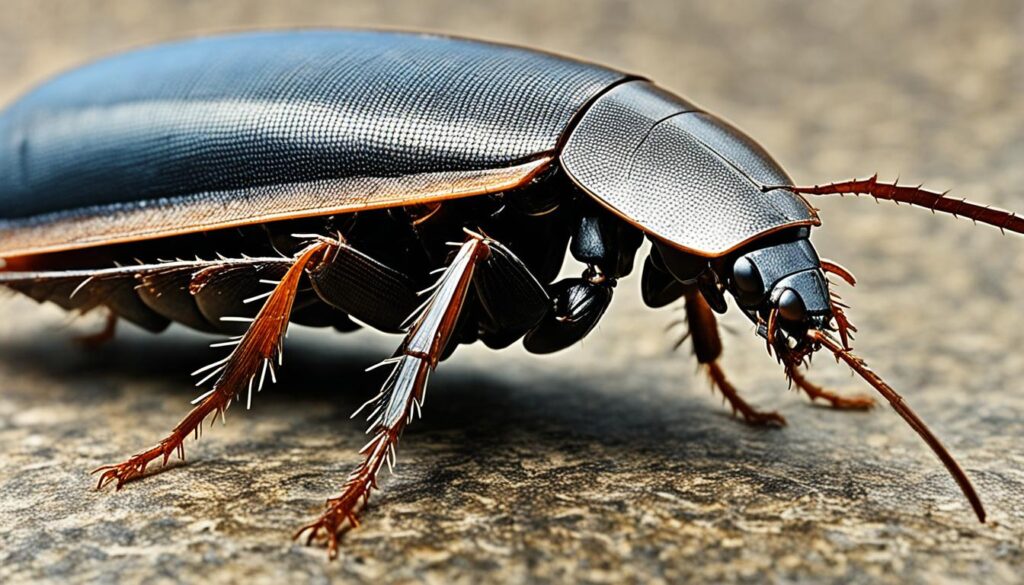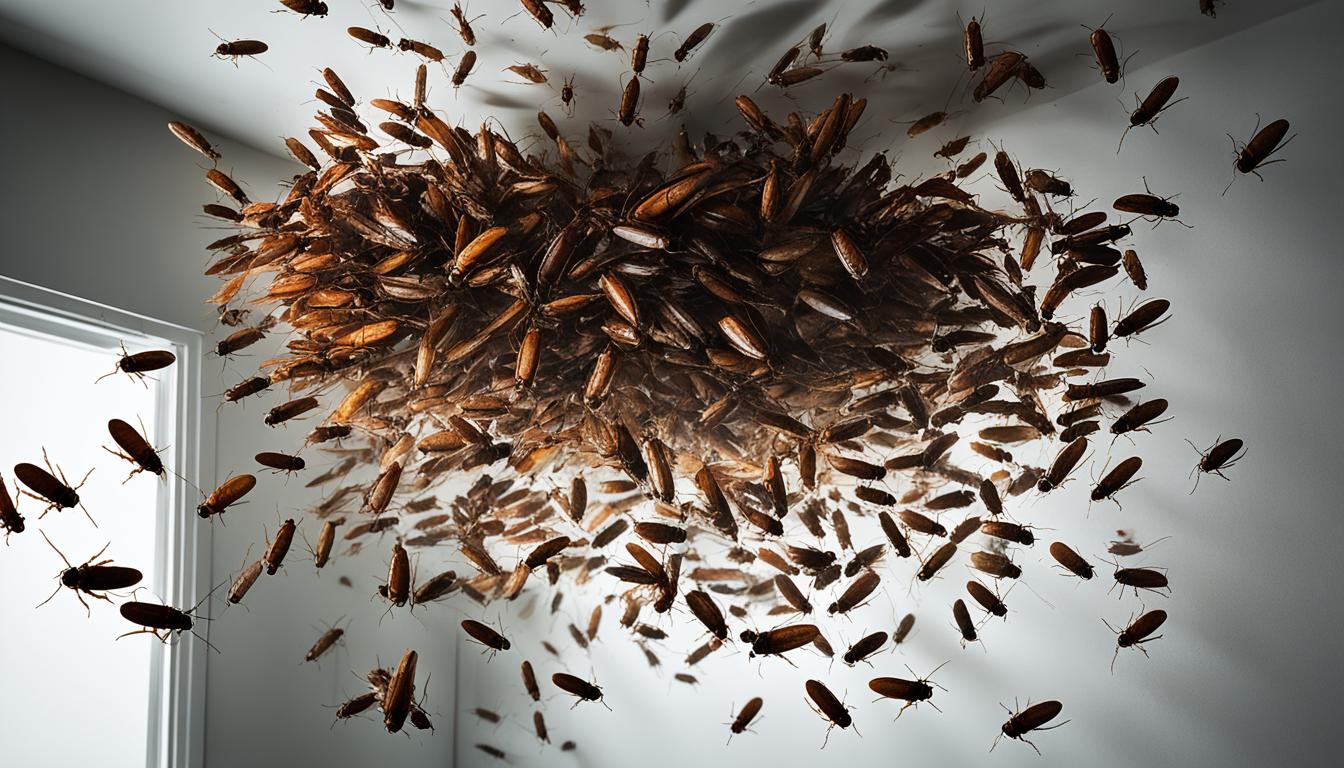Ever wondered where flying cockroaches come from? These bugs have survived millions of years, changing to fit different places on Earth. But, what’s the real story of these annoying insects in your home? Let’s dive into how they started and why they’re now found in unexpected spots.
Key Takeaways
- Cockroaches have been around for millions of years, with fossil records tracing their origins to the tropics.
- Some cockroach species, like the Asian and Cuban cockroaches, are capable fliers and can easily enter homes through windows, doors, and cracks.
- Flying cockroaches can contaminate food, spread diseases, and pose health risks to residents.
- Cockroaches have adapted to a wide range of habitats, from rainforests to the Arctic, making them a global pest problem.
- Understanding the origins and adaptations of flying cockroaches is crucial for effective prevention and control measures.
The Ancient Origins of Cockroaches
Cockroaches are very ancient insects, with their history going back 320 million years to the Carboniferous period. They are known for being able to live in many different places, from very cold to very warm. The secret of their success lies in their ability to adapt over time.
Fossil Records and Evolutionary Adaptations
Fossils show that the first known cockroach lived around 235 million years ago, when all the world’s continents were joined in Pangaea. As the continents moved apart, different types of cockroaches started to appear. This is how they became the diverse group we know today.
It’s surprising that cockroaches look much the same as they did millions of years ago. They can run 50 times their length in one second and can survive 15 times more radiation than people. They have a smart way of using their wings to protect themselves and have super quick senses on their legs to avoid danger.
Even though cockroaches are very old, they are still evolving and becoming more diverse. By studying the DNA of 119 different species, scientists have understood better their family tree. Fossils show that the cockroach family has been evolving for up to 180 million years.
Today, we know of more than 4,600 types of cockroaches. The largest is the Australian giant burrowing cockroach. It can grow to an impressive 8 centimeters and weigh 35 grams. On the other hand, the smallest are the Attaphila cockroaches, which are just 3.5 millimeters and live with leaf-cutter ants.
Cockroaches have survived through the years, always adapting to their surroundings. Their long history and amazing abilities interest both scientists and those who work in pest control.
Why Cockroaches Have Survived for Millions of Years
Cockroaches have been on Earth for a very long time. They’ve survived millions of years because of their special abilities. These abilities help them adapt and live in very tough places. Their unique characteristics are a big part of why they’re still around.
Resilient Characteristics and Survival Habits
Cockroaches can survive without food for a month and without water for two weeks. They are great at living through tough times. They can also go without air for up to 40 minutes, which helps in low-oxygen areas.
They can run incredibly fast, up to three miles per hour. That speed is 50 body lengths in just one second! This helps them escape danger and find food quickly. They are also not easily caught by many predators, like lizards, snakes, and birds. This adds to their survival success.
Where do flying cockroaches come from?
Not all cockroaches can fly. But some, like the Asian cockroach, have learned to do it. Flying cockroaches are drawn to light and can fly towards it. This gives them an advantage over ground-dwelling cockroaches, like the German cockroach, who can’t fly.
Cockroaches have survived so long because they can live in many places. They have special traits that let them do this. This makes them a very successful species on our planet.

The German Cockroach’s Global Spread
The German cockroach gets its name from when Carl Linnaeus found it in Germany. It is now in buildings worldwide, not just Germany. Even though its roots are in Europe, its closest relatives live in Africa and Asia. This cockroach comes from the Asian cockroach, and it started living near people around 2,100 years ago.
German cockroaches are now all over the world, except Antarctica. They are the most common of the 4,600 cockroach species. Research shows these cockroaches come from Asia and were found in India and Myanmar over 2,000 years ago.
About 1,200 years ago, German cockroaches went to the Middle East, likely because of trade and movement of armies. They reached Europe and the rest of the world about 390 years ago. They were helped by better transportation, European trade, and warm homes. They can’t fly on their own; people carry them as they travel.
In places like Singapore and Australia, German cockroaches are more like the ones in the U.S. This is because of old trading connections. Knowing this helps us understand how these pests have spread worldwide.
| Milestone | Timeline |
|---|---|
| German cockroaches evolved from Asian cockroach | Around 2,100 years ago |
| German cockroaches arrived in the Middle East | About 1,200 years ago |
| German cockroaches spread to Europe and globally | Around 390 years ago |
| German cockroaches first recorded in Europe | Around 270 years ago |
The German cockroach has quickly spread across the globe, showing how adaptable and strong it is. As a top invasive species, it’s a big problem for people and their health everywhere.
Cockroach Invasions and Human Settlements
The German cockroach thrives in a globalized world. They began spreading around 1,200 years ago. This spread was aided by the Umayyad and Abbasid Caliphates. Later, European colonial trade helped them move east. New technology, like faster ships and planes, also played a big role. Thus, they have spread across the world thanks to human activities.
Inadvertent Hitchhikers in Trade and Military Movements
Transport progress boosted cockroach spread. By the 20th century, they were everywhere except Antarctica. Things like indoor heating and plumbing let them live in colder places too. Now, scientists have found over 4,600 cockroach species. The American and German cockroaches are most often found in homes.
| Cockroach Species | Typical Size | Habitat Preferences |
|---|---|---|
| German Cockroach | ¼ to ½ inch | Kitchens, bathrooms, electrical appliances |
| American Cockroach | Around 3 times larger than German cockroach | Damp areas, water sources, organic matter |
| South American Megaloblatta longipennis | Nearly 7 inches | Forests |
| Attaphila fungicola | Less than 1 inch | Texas |
The World Health Organization (WHO) calls cockroaches “unhygienic scavengers in human settlements.” They can spread sicknesses like salmonella, diarrhea, and dysentery. To stop them, keep your home clean and fix leaks right away. If you need help, get in touch with pest control experts.
Genetic Evidence of Cockroach Migration Patterns
Researchers studied over 280 German cockroaches from 17 countries. They found that cockroaches from Singapore and Australia are closer to those in the U.S. than in nearby Indonesia. This suggests the U.S. had stronger links with these countries. These connections likely helped cockroaches travel far and wide over time.
This study shows how human actions and natural processes are linked. By moving with humans, cockroaches have spread across the planet. By looking at their genetics and movements, scientists learn how these insects survive and spread. This knowledge helps in finding new ways to control them.

The research focused on the genes of more than 280 cockroaches. They were from 17 countries and six continents. The study indicated these insects came from Southeast Asia about 2,100 years ago. They then spread west to the Middle East 1,200 years ago. Finally, they made their way to Europe through trading routes about 270 years ago.
Cockroaches show incredible adaptability through their history alongside humans. They have evolved to resist many traditional controls. In this fight, studying their genes and movements is key to managing their populations.
Cockroach Adaptability and Rapid Evolution
The German cockroach, Blattella germanica, is well-known for its cockroach adaptability and rapid evolution. It’s hard to control due to these traits. Originating from Asia 2,100 years ago, it has spread across the globe. It has thrived in many different environments created by humans.
The German cockroach quickly becomes resistant to pesticides and control methods. For instance, cockroaches that survived efforts to kill them with glucose-soaked poison have developed a dislike for sugar. Even new poisons face resistance in laboratory tests before their release.
Its fast birth rate helps the German cockroach adapt swiftly. Genetic studies show that it split from its close relative just 2,100 years ago. Yet, it has spread worldwide and thrived in many human-made places.
In the United States, it costs over $16 billion a year to control cockroaches. The German cockroach gets about 15% of this attention. Growing cities and human developments are ideal for these adaptable pests. So, they are a growing problem to face.
The challenge of controlling the German cockroach continues to grow. Developing better strategies is key. This involves recognizing its amazing adaptability and evolution.
The Unstoppable March of the German Cockroach
The German cockroach is famous for being the most common cockroach species worldwide. It lives on every continent except Antarctica. They can easily adapt and spread through modern transport, becoming a big problem.
Cockroach infestations are especially worrisome in poor areas. In these places, controlling German cockroaches is tough. Sadly, it seems like they’ll keep spreading.
These insects have been here for over 200 million years. They’ve survived huge catastrophes that killed the dinosaurs. Today, they can go a month without eating and a week without water. They have lots of babies too, up to 150 each year.
The German cockroach, in particular, poses a great challenge. It grows from 1.1 to 1.5 inches and breeds fast. They quickly get used to efforts to control them. They love places with food and water, like homes and restaurants.
| Cockroach Species | Average Size | Lifespan | Offspring per Year |
|---|---|---|---|
| German Cockroach | 1.1 – 1.5 inches | N/A | Up to 150 |
| Brown-Banded Cockroach | 0.5 inches | 200 days | N/A |
| Oriental Cockroach | 1.25 inches (female), 1 inch (male) | N/A | N/A |
Cockroaches can be really bad for public health, spreading illness and causing allergies. You can see their droppings and eggs, and sometimes smell them when they’re around.
If you think you have a German cockroach problem, don’t hesitate to call in professionals. Go-Forth Home Services, with over 50 years of experience, offers safe solutions to get rid of them.
Conclusion
The story of how cockroaches started and survived over time, including the tough German cockroach, is quite interesting. They’ve been around for millions of years, getting along with people and expanding worldwide. Studying their genetic journeys helps us understand how our actions affect the growth of these pests.
Dealing with roach problems is hard, but knowing how they’ve adapted and changed over the years helps in fighting them. Using various methods like natural solutions and professional help is usually the best way to keep them under control.
As cockroaches remain a problem in our homes and neighborhoods, it’s crucial to keep learning and acting against them. Staying updated on research and control techniques lets you safeguard your home and keep it clean and safe.
